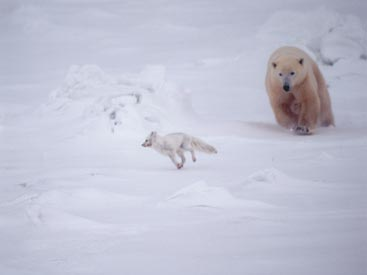Can't we all just get along?

The Arctic fox is a predator of lemmings, ground-nesting seabirds, young seals, and a variety of other small wildlife. Because the lemming is its primary food source, the Arctic fox population is very closely linked with the lemming population. Lemmings have a three to four year cyclic pattern of booming populations and collapsing populations, and this has a major effect on predators (McGonigal, 2001). Because the Arctic fox is not a very migratory creature, it often starves when the lemming population peaks, starves, and collapses. Thus, when the lemming populations are low, the Arctic fox populations soon decrease as well. However, the Arctic fox is also prey. When food is scarce the fox will often trail polar bears or wolves, but it must be very careful because if either catches it, it'll become the next meal on the menu! Polar bears and wolves are not the only animals that feed on Arctic foxes, however. The fox also falls prey to creatures such as owls and eagles, whose sharp eyes are able to spot the fox as it moves over the ice and snow. Humans, too, have their uses for the Arctic fox, and it seldom involves the fox being alive.
The primary disease responsible for killing off Arctic fox communities is rabies. Parasitic ear mites introduced by domestic dogs have also been observed to have a devastating effect on Arctic fox populations. An interesting observation has been made regarding plant growth and its effect on the fox population. Lemmings rely on plants for food, so when plant growth is limited or the lemming population overwhelms the available food supply, the population crashes, resulting in a corresponding crash in the Arctic fox population, which relies on lemmings as a primary food source. According to A Complete Guide to Arctic Wildlife, "the introduction of Arctic foxes to the Aleutian Islands had disastrous consequences for several populations of ground-nesting birds" (Sale, 2006) as they preyed very heavily on the bird populations.
Human uses for the fox primarily involve the high demand for Arctic fox fur, which can be used to make luxurious coats. In most cases, the foxes are hunted and trapped for their skins, although raising foxes for their coats has become somewhat common, and raising the rarer blue phase foxes has become something of an important industry (Nowak, 1999). Despite extensive trapping by humans nearly eliminating the Arctic fox population in some areas, it shows surprisingly little fear of humans, often sneaking into camps and stealing food.
